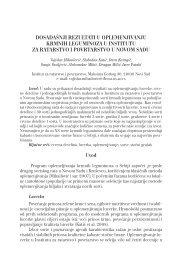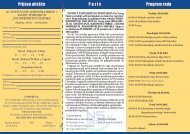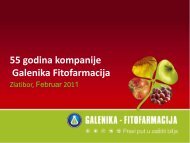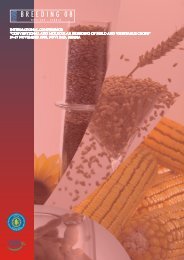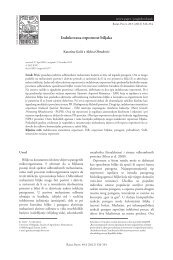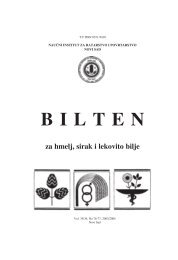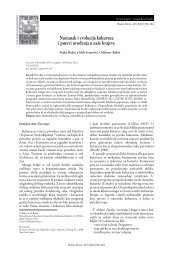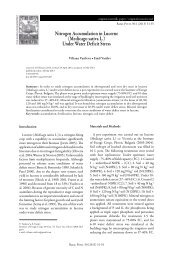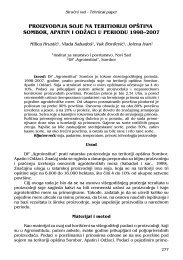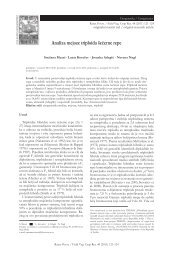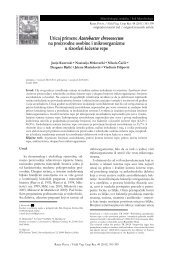Principal Component Analysis of Tomato Genotypes Based ... - CEON
Principal Component Analysis of Tomato Genotypes Based ... - CEON
Principal Component Analysis of Tomato Genotypes Based ... - CEON
You also want an ePaper? Increase the reach of your titles
YUMPU automatically turns print PDFs into web optimized ePapers that Google loves.
<strong>Tomato</strong> <strong>Genotypes</strong> PCA <strong>Based</strong> on Quality Indicators 299<br />
1998). High content <strong>of</strong> vitamin C in tomato fruit<br />
determinates its high biological value. However,<br />
ascorbic acid content is highly unstable and varies<br />
greatly depending on environmental conditions.<br />
In the assessed material, vitamin C content<br />
ranged from 650.4 to 1027.1 mg/100 g dm, with<br />
CV 13.42%. The richest genotype in vitamin C<br />
was Novosadski rani, while the least content was<br />
measured in the variety Novosadski export.<br />
Locule number has an influence on the fruit<br />
shape and size. In the analyzed genotypes locule<br />
number ranged from 2.0 to 10.2 with CV<br />
56.19%. Local population Đevđelijski, with the<br />
smallest fruit (after populations Bitoljski rani<br />
and Tetovski), had the lowest locule number,<br />
while cultivar Novosadski rani, with the most<br />
flattened fruit had the highest locule number in<br />
the examined material.<br />
Fruit shape is usually calculated as fruit height<br />
and width ratio, known as “fruit shape index”<br />
(Gonzalo & Van der Knaap, 2008). Round<br />
fruits <strong>of</strong> uniform size are favourable for manual<br />
harvesting, while elongated fruits facilitate<br />
mechanical harvesting. Fruit index ranged from<br />
0.5 to 1.0 with CV 16.87%. Novosadski rani<br />
had the lowest index <strong>of</strong> fruit shape and the most<br />
flattened, ribbed fruit. Although consumers’<br />
demands are different, most <strong>of</strong> them require<br />
round tomatoes with uniform size.<br />
The second component accounts for<br />
approximately 23.76% <strong>of</strong> the total variance. This<br />
component is defined by dry matter content and<br />
total acidity.<br />
Dry matter content is a very important<br />
indicator <strong>of</strong> fruit quality, both for canning<br />
industry and fresh consumption. Dry matter<br />
<strong>of</strong> tomato fruit is comprised <strong>of</strong> water-soluble<br />
dry matter (about 88%) originating mainly<br />
from sugars, acids, proteins and water-soluble<br />
pectic substances (pectinic acid). Cellulose,<br />
hemicellulose, pectic acid and protopectin are<br />
water-insoluble components (Tepić et al., 2006).<br />
<strong>Tomato</strong>es with high dry matter content are<br />
highly desirable in processing as they significantly<br />
increase the quality <strong>of</strong> the processed product (De<br />
Pascale et al., 2001). Determined dry matter<br />
values ranged from 5.4 to 6.8% with CV 7.6%.<br />
The highest value was measured in old cultivar<br />
Rutgers, while cultivar Novosadski rani had the<br />
least dry matter content. Majority <strong>of</strong> analyzed<br />
genotypes had dry matter content above 6.0%.<br />
Acids content is very important for fruit<br />
flavour and for quality <strong>of</strong> processed tomato. The<br />
most common acids in tomato fruit are: citric,<br />
malic and oxalic. The amount <strong>of</strong> organic acids in<br />
tomato fruits depends on the variety, degree <strong>of</strong><br />
maturity and growing conditions. The lowest acids<br />
content (4.6 g/100g dm) was measured in local<br />
population Tetovski, while cultivar Novosadski<br />
rani was characterized with the highest acidity<br />
value (8.6 g/100g dm). This quality parameter<br />
had CV 19.49% in the analyzed material.<br />
The third principal component contributes<br />
21.57% <strong>of</strong> the total variance. The most important<br />
traits in this component were: lycopene, fruit<br />
mass and fruit colour.<br />
<strong>Tomato</strong> is one <strong>of</strong> the main sources <strong>of</strong> lycopene.<br />
Carotenoid lycopene is a natural antioxidant, very<br />
important in prevention <strong>of</strong> many diseases. The<br />
fact that human organism is not able to synthesize<br />
lycopene increases the importance <strong>of</strong> tomato in<br />
nutrition, and therefore in breeding programs.<br />
Varieties rich in lycopene are very important for<br />
industrial processing and for fresh consumption as<br />
well, since consumers are demanding food with high<br />
nutraceutical values. Analyzed genotypes were very<br />
divergent in lycopene content since it ranged from<br />
320.0 to 1,550.9 mg/100 g dm with CV 34.01%.<br />
The highest amount <strong>of</strong> lycopene was established<br />
in local population Bitoljski kasni, while the least<br />
amount <strong>of</strong> lycopene was measured in cultivar<br />
Golden jubilei, since it has orange fruit colour.<br />
Fruit mass depends on many factors: varieties,<br />
environmental conditions, type <strong>of</strong> growing, etc.<br />
Depending on the mass, fruits are classified into<br />
groups: large (120-250 g), medium (80-120 g),<br />
small (60-80 g) and also cocktail (30-50 g) and<br />
cherry types (10-30 g) (Đurovka et al., 2006).<br />
Fruit mass varied from 49.3 to 200.0 g with CV<br />
44.97%. Bearing in mind that this trait defines<br />
cultivar purpose, divergence <strong>of</strong> genetic material in<br />
fruit mass is very significant for breeding programs.<br />
Old cultivar Rutgers had the highest fruit mass,<br />
and also the highest dry matter content, among<br />
all analyzed genotypes. Local population Bitoljski<br />
rani had the lowest fruit mass.<br />
Colour is an important quality indicator.<br />
Depending on structures and concentrations <strong>of</strong><br />
carotenoids (lycopene, β-carotene, ζ-carotene,<br />
etc.) tomato colour may be: red, orange, yellow,<br />
purple, or even white. All analyzed genotypes had<br />
red fruits apart from one cultivar, Golden jubilei.<br />
Ratar. Povrt. 49:3 (2012) 296-301



